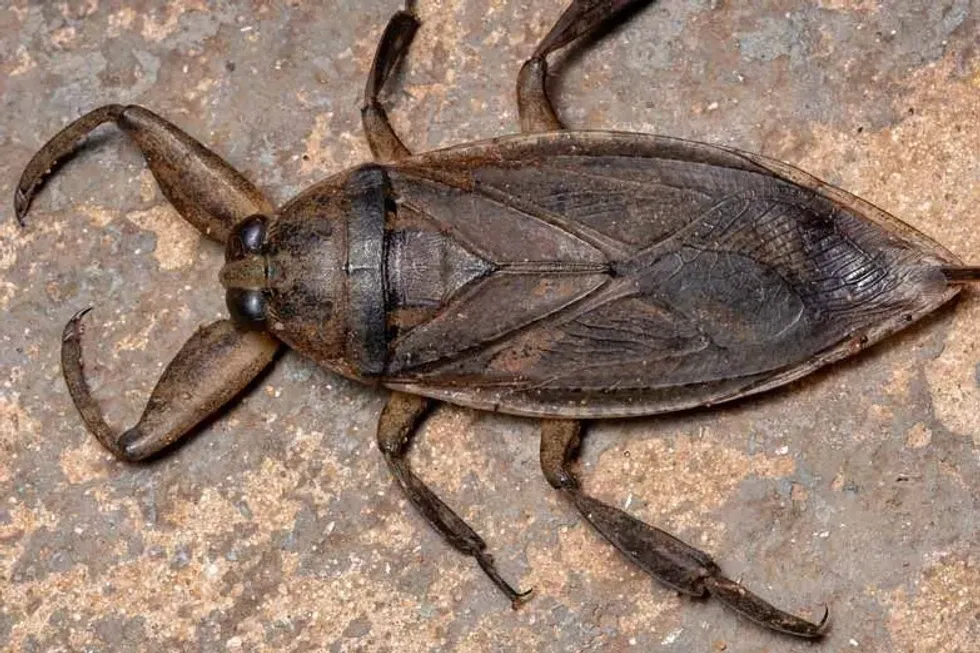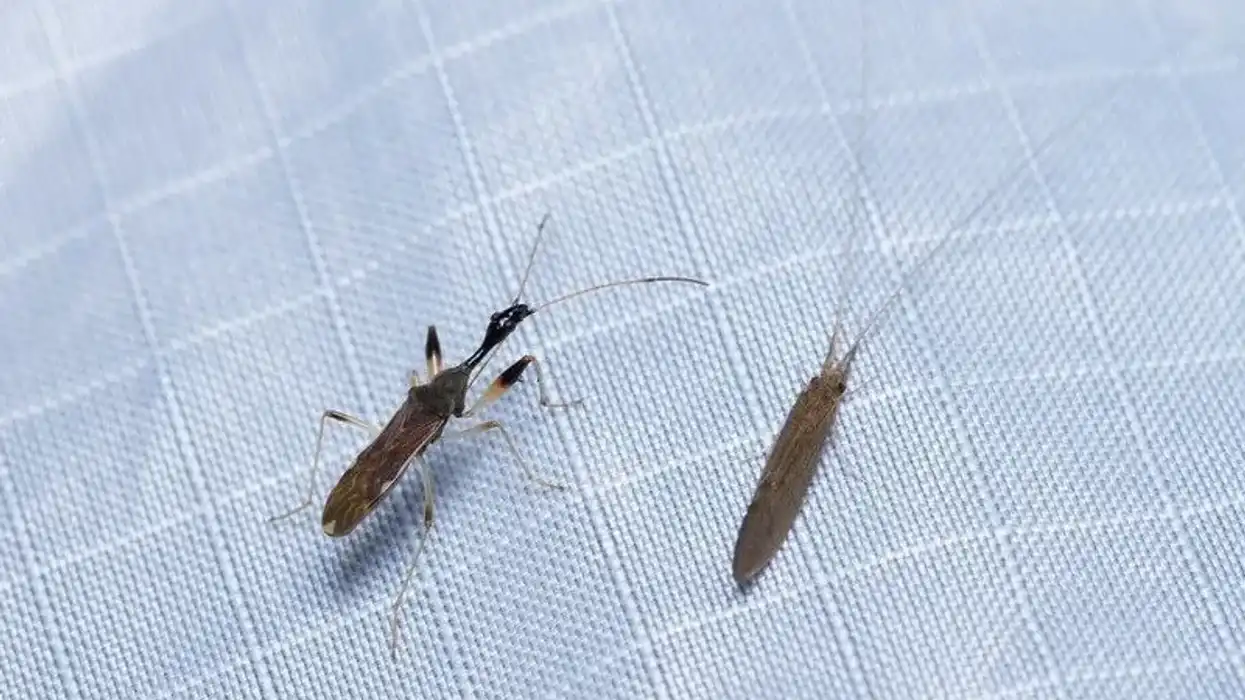The giant water bug, or Lethocerus americanus, is an insect that comes from the family of Belostomatidae. This insect is generally found in freshwater ponds, slow-moving ponds, and marshes. These bugs go by the common name of electric light bugs, toe biters, Indian toe biters, alligator fleas, or alligator ticks.
These bugs, who are a member of the family Belostomatidae, generally lie motionless near or on the bottom of the freshwater bed. They wait for their prey, and upon contact, they strike. Although they don't have a painful bite, the saliva that they secrete from their rostrum is venomous but doesn't require any kind of medical attention.
These bugs are a member of the order Hemiptera. They are the biggest bugs found in the region of Canada and the United States and can grow up to 4.5 in (12cm). Their appearance can be confused with a beetle or a cockroach. They have an oval-shaped flat body that is brown in color.
Although these bugs which are a member of the order of Hemiptera are considered not to be dangerous despite the painful bite they have, when it comes down to hunting their prey down they do secrete toxins that paralyze the prey and liquefies the internals.
Being a bug it is capable of being a ruthless predator for aquatic insects, amphibians, crustaceans, fishes, salamanders, and tadpoles. They have hind legs which resemble oars which help them swim across the ponds and the marshes.
Keep on reading if you want to know more about the giant water bug's location and facts about these predators. If you are interested in knowing about more related species, check out the yellow jacket wasp and the mud dauber wasp.
Giant Water Bug Interesting Facts
What type of animal is a Giant Water Bug?
The giant water bug (Lethocerus americanus) is a type of insect.
What class of animal does a Giant Water Bug belong to?
The giant water bug belongs to the class of Insecta and the order of Hemiptera.
How many Giant Water Bugs are there in the world?
Although the exact number of Giant Water Bugs in the world is not known, there are around 170 species of giant water bug (Lethocerus americanus) that are found in freshwater ponds, slowly moving ponds, and marshes worldwide, of which 110 are found in the tropical terrestrial regions of America, and around 20 in Africa.
Where does a Giant Water Bug live?
Generally, these electric light bugs (Lethocerus americanus) can be found in freshwater ponds, slow-moving ponds, and marshes. These true bugs can easily be found in the ponds of North America.
What is a Giant Water Bug's habitat?
The giant water bug is found hidden under the wetlands of vegetation just lying dead on the surface of the water. The most desirable habitat for these aggressive predators is freshwater ponds, slowly moving ponds and marshes.
Who do Giant Water Bugs live with?
Though there is no intensive research, giant water bugs (true bugs) generally live in solitude. Being in groups can make them slow in terms of preying.
How long does a Giant Water Bug live?
An adult insect of this species is said to live for one year. These aquatic beings don't have a very long lifespan. Still, they are quite a dangerous species for an insect.
How do they reproduce?
The mating season for these electric light bugs or Lethocerus americanus starts in spring and early summer. Females lay around 100 - 150 eggs and the males carry them.
Nymphs are hatched about one-two weeks after maturing from eggs. After reaching the stage of adulthood, in about two months, they spend their winter in the bottoms of ponds or marshes.
What is their conservation status?
The conservation status of these insects is Not Listed in the International Union for Conservation of Nature or IUCN red list. Though these insects are found in freshwater ponds, slow-moving lakes or ponds, and marshes quite commonly. However, the only threat to the population of this species is water pollution, bullfrogs, and crayfish.
Giant Water Bug Fun Facts
What do Giant Water Bugs look like?

*Please note that this an image of a water bug that belongs to the same family as the giant water bugs.
These flat oval-shaped giant water bugs are brown. They have a pointed beak that overlaps over the abdomen which makes the shape of an 'X'. The front legs of this insect are meant to grasp the prey and the hind legs are meant for swimming as they are of oar-like structure.
How cute are they?
This six-legged bug is not really cute but if you find cockroaches or beetles cute, then you will definitely find these Giant Water Bugs cute. The appearance of these aquatic bugs is generally confused with that of roaches or beetles.
How do they communicate?
Giant Water Bugs make ripple signals in water which are made with the legs being in contact with the water. These aquatic insect hunters which are the members of the order Hemiptera, vertically oscillate their bodies to communicate with their ripple signals. Their signals vary from a frequency from 2 - 3 Hz to up to 100 Hz.
How big is a Giant Water Bug?
Although the appearance of the giant water bug is confused with that of a cockroach, though they are nothing alike. Adult giant water bugs can grow up to 0.35 - 4.5 in ( 0.9 - 12 cm) long which is almost three times bigger than a cockroach. These species are big enough to prey on aquatic insects.
How fast can Giant Water Bugs move?
These oval-shaped insects with flat bodies have a hydrodynamic-rich body. Although their exact speed is not known, they have legs in the shape of an oar which helps them swim quick enough to catch their prey with their front legs.
How much does a Giant Water Bug weigh?
There is no specific study that states the weight of this species from the family of Belostomatidae.
What are their male and female names of the species?
There is no specific name associated with the gender of this species. They are generally referred to as male or female giant water bugs.
What would you call a baby Giant Water Bug?
Baby Giant Water Bugs are called a nymph. A nymph is hatched after maturing within 2 - 3 weeks of female laying eggs, and the males carry them.
What do they eat?
These bugs are a member of the order of Hemiptera which are carnivores that survives on aquatic insects, fishes, salamanders, and tadpoles. These four-inch insects are formidable nimrods that are capable of preying on turtles, snakes, or for that matter a duckling.
Are they harmful?
Generally, this Lethocerus americanus go by a common name like toe-biters. They have earned this name as a giant water bug bite is considered to be one of the most painful insect bites. Even though the bite doesn't require any medical assistance unless the victim experiences allergies, vomiting sensations, swelling around the bitten area, fever, or difficulty in breathing.
Would they make a good pet?
This Lethocerus americanus is nowhere close to being domesticated because they won't survive in an artificial habitat. You can always find a giant water bug flying towards its prey near marshes, or swimming under freshwater ponds, or slowly moving lakes but you cannot pet them.
Did you know...
They are known by many common names and each has its explanation, for instance, they are called electric light bugs as they are attracted towards lights of cars and porch lights. This explains why they're always found lurking around in the parking lots.
These bugs can also fly. The moment they leave the water they can be found lurking around lights.
Interestingly, a Lethocerus americanus can survive underwater for a long time in a single stretch just by converting the air bubble into oxygen with their gills which are present on their body. They have a special mechanism that is considered to be rather a defense as they can squirt an awful odor from their anus.
These toe-biters can have a painful bite which helps them hunt better. They secrete a toxin from their sharp beak which upon penetration into the prey not only can paralyze it but also liquify the internals making it easy for the bug to suck up all the liquid inside the prey.
The exact price of giant water bugs is not known.
Why are they called Giant Water Bugs?
Giant water bugs as their name suggests are giant bugs that can be up to 4 inches long and that live underwater in order to hunt.
How long can a water bug live underwater?
As the bug is capable of transforming air bubbles into oxygen by gaping for about 20 minutes, bugs can almost double or triple their underwater time.
Here at Kidadl, we have carefully created lots of interesting family-friendly animal facts for everyone to discover! Learn more about some other arthropods including the giant African millipede and the atlas beetle.
You can even occupy yourself at home by drawing one of our Giant water bug coloring pages.










